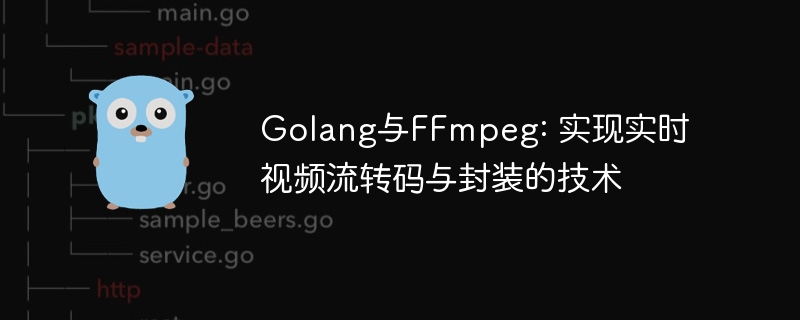

Golang and FFmpeg: Real-time video stream transcoding and encapsulation technology requires specific code examples
Overview:
In today's Internet era, video has become an integral part of people's lives. However, due to the inconsistency of video formats and differences in network environments, there are often some problems in directly transmitting videos over the network, such as slow transmission speeds and reduced video quality. To solve these problems, we can use video transcoding and encapsulation technology to encode and decode the video stream and encapsulate it into a format suitable for network transmission. This article will introduce how to use Golang and FFmpeg to implement real-time video stream transcoding and encapsulation technology, and give specific code examples.
Technical background:
Golang is a powerful programming language. It has the characteristics of high concurrency, simplicity and ease of use, and fast compilation. It is suitable for network programming. FFmpeg is a cross-platform audio and video processing tool that can handle almost all common audio and video formats. Combining Golang and FFmpeg, we can achieve efficient video stream transcoding and encapsulation.
Specific implementation steps:
Specific code examples:
package main
// 导入FFmpeg相关的头文件
/*
#cgo LDFLAGS: -lavformat -lavcodec -lavutil
#include <libavformat/avformat.h>
#include <libavcodec/avcodec.h>
*/
import "C"
import (
"fmt"
)
func main() {
// 输入文件名和输出文件名
inputFileName := "input.mp4"
outputFileName := "output.mp4"
// 打开输入文件流
var inputFormatCtx *C.AVFormatContext
if C.avformat_open_input(&inputFormatCtx, C.CString(inputFileName), nil, nil) != 0 {
fmt.Printf("Failed to open input file
")
return
}
// 查找视频流信息
if C.avformat_find_stream_info(inputFormatCtx, nil) < 0 {
fmt.Printf("Failed to find stream information
")
return
}
// 打开输出文件流
var outputFormatCtx *C.AVFormatContext
C.avformat_alloc_output_context2(&outputFormatCtx, nil, nil, C.CString(outputFileName))
if outputFormatCtx == nil {
fmt.Printf("Failed to allocate output format context
")
return
}
// 复制视频流信息到输出流
for i := C.uint(0); i < inputFormatCtx.nb_streams; i++ {
stream := inputFormatCtx.streams[i]
outputStream := C.avformat_new_stream(outputFormatCtx, stream.codec.codec)
if outputStream == nil {
fmt.Printf("Failed to allocate output stream
")
return
}
// 复制流的参数
if C.avcodec_parameters_copy(outputStream.codecpar, stream.codecpar) < 0 {
fmt.Printf("Failed to copy codec parameters
")
return
}
}
// 打开输出文件
if C.avio_open(&outputFormatCtx.pb, C.CString(outputFileName), C.AVIO_FLAG_WRITE) < 0 {
fmt.Printf("Failed to open output file
")
return
}
// 写入文件头部
if C.avformat_write_header(outputFormatCtx, nil) < 0 {
fmt.Printf("Failed to write header
")
return
}
// 读取视频流数据并进行编码处理
packet := C.AVPacket{}
for C.av_read_frame(inputFormatCtx, &packet) == 0 {
stream := inputFormatCtx.streams[packet.stream_index]
outStream := outputFormatCtx.streams[packet.stream_index]
// 编码帧数据
if C.avcodec_send_packet(stream.codec, &packet) < 0 || C.avcodec_receive_packet(stream.codec, &packet) < 0 {
fmt.Printf("Error while encoding
")
return
}
packet.stream_index = outStream.index
packet.pts = C.AV_NOPTS_VALUE
packet.dts = C.AV_NOPTS_VALUE
// 封装编码后的数据
if C.av_interleaved_write_frame(outputFormatCtx, &packet) < 0 {
fmt.Printf("Error while writing frame
")
return
}
C.av_packet_unref(&packet)
}
// 结束封装
C.av_write_trailer(outputFormatCtx)
// 关闭输入输出流
C.avformat_close_input(&inputFormatCtx)
if outputFormatCtx != nil && outputFormatCtx.pb != nil {
C.avio_close(outputFormatCtx.pb)
}
C.avformat_free_context(outputFormatCtx)
fmt.Printf("Done
")
}Summary:
By using Golang and FFmpeg, we can easily achieve transcoding and encapsulation of real-time video streams. This article gives specific code examples and outlines the implementation steps. However, in actual projects, more details may need to be considered, such as exception handling, concurrency processing, etc. I hope this article can be helpful to beginners of real-time video streaming transcoding and encapsulation technology, and I also hope it can provide everyone with a learning direction and ideas.
The above is the detailed content of Golang and FFmpeg: Technology for real-time video streaming transcoding and encapsulation. For more information, please follow other related articles on the PHP Chinese website!
 How to define variables in golang
How to define variables in golang
 What are the data conversion methods in golang?
What are the data conversion methods in golang?
 What are the commonly used libraries in golang?
What are the commonly used libraries in golang?
 What is the difference between golang and python
What is the difference between golang and python
 What does margin mean in css
What does margin mean in css
 The advantages of OTC trading
The advantages of OTC trading
 Can program files be deleted?
Can program files be deleted?
 Object-Oriented Programming
Object-Oriented Programming
 What does CX mean in the currency circle?
What does CX mean in the currency circle?




